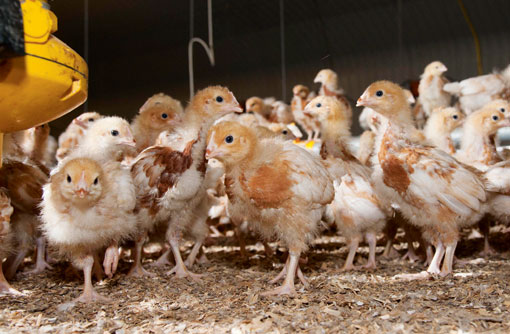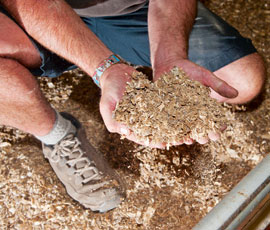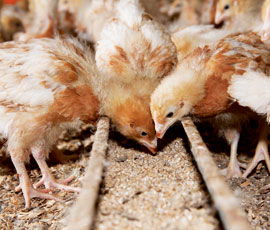Attention to detail essential to pullet rearing success

An increasing number of egg producers are considering rearing their own pullets – but one wrong move could devastate productivity of a whole crop. Olivia Cooper finds out what’s involved.
Rearing good quality pullets can be a balancing act – done correctly it sets the flock up for optimum performance, but one mistake can cause long-term damage.
The key, according to speakers at a training course organised by Duchy College, is attention to detail in producing to meet the layers’ objectives.
“As rearers, we need to produce pullets which are fit for purpose, and able to meet the expectations of the egg producer,” said Devon farmer and poultry trainer, John Moore. By 16 weeks of age, the pullets should be at their target bodyweight, with uniform development and healthy digestive and reproductive systems. They need to have an antibody profile to meet the laying site’s disease challenges, and be reared to a light programme that will deliver target egg weights.
“We like to know from the outset the layout of the house that the birds are going into, so we can replicate that. If the laying house has centre nests, we’ll put in centre perches, so the birds are looking for them when they move.”
Before ordering their first crop of chicks, potential rearers must ensure they have adequate housing facilities. Housing must be vermin and wild bird proof, and able to maintain a stable and controlled inside temperature, with good insulation and an adjustable lighting system.
“All ventilation inlets and outlets need light and wind baffles, to keep draughts and direct light out,” said Mr Moore. Ventilation plans should be drawn up, to provide a minimum of 0.4cu m of air per hour, per kilogram of bodyweight – with timers installed and adjusted according to age of the flock.
 Litter should be 5cm deep and in the form of shavings, shredded newspaper, or a shavings and straw mix. “Straw poses disease risks, and chicks burrow in it and get squashed. Newspaper is good, but is difficult in damp weather, and you’ll need to use shavings under canopy brooders due to the fire risk.”
Litter should be 5cm deep and in the form of shavings, shredded newspaper, or a shavings and straw mix. “Straw poses disease risks, and chicks burrow in it and get squashed. Newspaper is good, but is difficult in damp weather, and you’ll need to use shavings under canopy brooders due to the fire risk.”
The house should also be upwind and 200m away from any other poultry unit, to reduce the risk of Marek’s disease. “Attendants must have no contact with other birds until the chicks are at least four weeks old. You only need one person to break that biosecurity and the chicks will go down – and you won’t know until they come into lay. It’s a total disaster.”
Food and water
Feeding and drinking facilities must be sufficient for ad-lib consumption. “You need 5cm of trough space for each bird, with the capacity to deliver at least half of the daily intake in the last two hours of the birds’ day. They eat 60-70% of feed in that time, and need 1.4 times more water than feed – if they haven’t got sufficient feed and water they will suffer.”

Water meters should be calibrated so rearers can monitor water – and therefore feed – intake, and also administer vaccines at correct doses. One nipple drinker will serve 12 birds, or eight bell drinkers 1,000 birds.
Producers could opt for spot brooders, whole house heating or part house heating, said Mr Moore. “Brooders are ideal as the chicks choose their own environment.” Houses should be pre-heated to 32C at floor level, and 26C ambient – and after stocking, rearers should check the birds to see if they are huddled or spread out, indicating whether they are too cold or hot. “All life support systems and temperatures should be auto-monitored, with a stand-by generator and alarm.”
When the chicks arrive on farm, rearers should ensure they have sufficient, trained staff to unload, vaccinate and so on. “Park the lorry out of the wind, and don’t open the doors until you are ready to unload. Check all the batch codes, and if they are small chicks from pullet layers, raise the brooder temperatures by a couple of degrees.” The houses should have been cleaned and empty for two weeks, and swabbed for total bacteria counts and salmonella. Chick box liners and dead chicks should also be swabbed.
Chicks should be counted, weighed and vaccinated, and not tipped into the shed until they were all ready to go, he added. Chick suppliers should provide 102 chicks per 100 ordered – or 104 if from pullet layers – to account for mortality. “The chicks need the lights on for two to three hours after delivery, to give them time to eat and drink, and then turn the lights off for four hours to allow them to rest.
“When the lights come back on, it is a big stimulus for them to eat and drink – you can then gradually adjust the lights to suit the layers’ requirements, starting at 20 hours of light a day and reducing to about 10 hours by six weeks – or 12 hours for free-range units.” A slow decrease in lighting would result in larger egg size, more rapid drops would foster smaller eggs.
For the first 24 hours water should be served tepid. Crumb feed should be given for the first two weeks, followed by a change to meal over four days to allow the chicks’ gut to acclimatise. A growers’ meal could be fed from six weeks of age, depending on growth rates. “The first growth is the cheapest growth. I hand feed four times a day for the first week – you are looking to stimulate them all the while.”
Environmental control
House temperature should be dropped by 1-2C a day, to 20C at three-and-a-half weeks of age – or 14C for free-range layers. “Look at the forecast and pick the best time to turn the heat off, or down – and don’t be afraid to turn it back up if there’s a cold snap.”
Birds should be stocked at 20kg liveweight per sq metre, and the lighting intensity reduced from 20 lux to 10 lux at about four weeks. Producers should make all changes gradual, removing mini-drinkers and feed pans over a number of days.
Monitoring growth rates every week was essential, and producers should aim for 80% of the flock to be within 10% of the breed target for their age, said Mr Moore. Daily water and feed intakes should be recorded, and faecal egg counts taken from four weeks old. Blood samples and salmonella swabs should also be taken at 14 weeks old, to check for efficacy of the vaccine programme.
During rear, pullets are typically vaccinated for 16 different diseases, as well as coccidiosis, but certain customers also require specific or autogenous vaccines. These can be administered through fogging, water, eye drops, coarse spray or injection. “Be careful if sanitising or adding chlorine to water, as this can deactivate the vaccine. Withold water for an hour-and-a-half before vaccinating in the middle of the day, drain the lines and ensure the vaccine gets to every nipple. If you’re spraying the birds, turn the lights down to 15% of normal, and walk twice with an extended lance, as you’ll get less disturbance.”
Producers should try to walk the house frequently anyway, to produce birds that will be calm in the laying shed. “And try to have a two-to-three week vaccine-free period after the ILT (infectious laryngotracheitis) vaccine, with added chlorine to 2ppm to reduce secondary ILT problems.”
Perches should be located in areas of the shed where the nests will be in the laying house. “Provide 1.75cm per bird from 10 days old, and at least 40cm above the floor level. If birds swarm to a particular area, put a perch there so the timid ones can escape.”
Rearers should aim to feed 5.6kg per bird by 16 weeks old, including 0.5kg of starter crumbs. Mortality should be below 2%, with zero downgrades and an even flock throughout. When the time comes to load and transport the birds, producers should ensure sufficient, trained staff, with two walkers, two catchers, two vaccine administrators, one loader and one forklift operator capable of loading 2,000 birds an hour.
“Try to catch in the afternoon, and travel overnight, to arrive and turnout in the morning, ready for the hens to eat and drink. You should have a maximum of 50kg per module drawer (about 32 birds), and reduce that by 20% if the temperature exceeds 21C.” With such close attention to detail, rearers should be able to produce top-quality pullets capable of meeting, or exceeding breed standards for the duration of their laying cycle.
* For more information on pullet rearing courses, contact Duchy College on 0845 458 7485.
